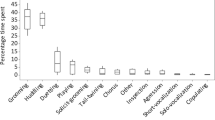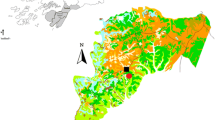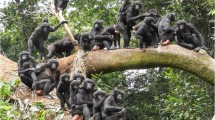Abstract
From long-term studies of a number of anthropoid species, many investigators have shown that kinship affinities affect social relationships. Factors such as proximity, social grooming, dominance rank, and mating patterns have been shown to be related to kinship. In this paper, we report the results of a preliminary study of the social organization of a group of prosimians (Lemur catta) in which individuals were identified and kinship affinities were known. We found that close matrilineal kin preferred to groom one another and to remain in close proximity more than did nonkin and distantly related animals. Furthermore, no copulations were observed within matrilines. These results are similar to those found in a number of species of anthropoids. This research was conducted on a semi-free-ranging group at the Duke University Primate Facility, Durham, North Carolina.
Similar content being viewed by others
References
Altmann, J. (1980).Baboon Mothers and Infants, Harvard University Press, Cambridge, Mass.
Herman, C. M. (1980). Mother-infant relationships among free-ranging rhesus monkeys on Cayo-Santiago: A comparison with captive pairs.Anim. Behav. 28: 860–873.
Berman, C. M. (1982). The ontogeny of social relationships with group companions among free-ranging infant rhesus monkeys. I. Social networks and differentiation.Anim. Behav. 30: 149–162.
Budnitz, N., and Dainis, K. (1975).Lemur catta; Ecology and behavior. In Tattersall, I., and Sussman, R. W. (eds.),Lemur Biology, Plenum Press, New York, pp. 219–235.
Cheney, D. L. (1977). The acquisition of rank and the development of reciprocal alliances among free-ranging immature baboons.Behav. Ecol. Sociobiol. 2: 303–318.
DeWaal, F. B. M. (1977). The organization of agonistic relations within two captive groups of Java monkeys (Macaca fascicularis).Z. Tierpsychol. 44: 225–282.
Hausfater, G., Altmann, J., and Altmann, S. (1982). Long-term consistency of dominance relations among female baboons (Papio cynocephalus).Science 217: 752–754.
Hinde, R. A. (ed.) (1983).Primate Social Relationships: An Integrated Approach, Blackwell Scientific, Oxford.
Jolly, A. (1966):Lemur Behavior, University of Chicago Press, Chicago.
Jolly, A. (1980).A World Like Our Own: Man and Nature in Madagascar, Yale University Press, New Haven, Conn.
Kaplan, J. R. (1977). Patterns of fight interference in free-ranging rhesus monkeys.Am. J. phys. Anthrop. 47: 279–288.
Kaplan, J. R. (1978). Fight interference and altruism in rhesus monkeys.Am. J. phys. Anthrop. 49: 241–250.
Kawamura, S. (1958). Matriarchal social ranks in the Minoo-B troop: A study of the rank system of Japanese monkeys.Primates 1-2: 149–156.
Koyama, N. (1967). On dominance rank and kinship of a wild Japanese monkey troop in Arashiyama.Primates 8: 189–216.
Koyama, N. (1970). Changes in dominance rank and division of a wild Japanese monkey troop in Arashiyama.Primates 11: 335–390.
Kurland, J. A. (1977).Kin Selection in the Japanese Monkey, Vol. 12, Contrib. Primatol., Karger, Basel.
Massey, A. (1977). Agonistic aids and kinship in a group of pigtail macaques.Behav. Ecol. Sociobiol. 2: 31–40.
Missakian, E. A. (1972). Genealogical and cross-genealogical dominance relations in a group of free-ranging rhesus monkeys (Macaca mulatto) on Cayo Santiago.Primates 13: 169–180.
Pusey, A. E. (1980). Inbreeding avoidance in chimpanzees.Anim. Behav. 28: 543–552.
Sade, D. S. (1965). Some aspects of parent-offspring and sibling relations in a group of rhesus monkeys, with a discussion of grooming.Am. J. phys. Anthrop. 23: 1–17.
Sade, D. S. (1967). Determinants of dominance in a group of free-ranging rhesus monkeys. In Altmann, S. (ed.),Social Communication among Primates, University of Chicago Press, Chicago, pp. 99–114.
Sade, D. S. (1968). Inhibition of son-mother mating among free-ranging rhesus monkeys.Sci. Psychoanal. 12: 18–38.
Sade, D. S. (1972a). A longitudinal study of social behavior of rhesus monkeys. In Tuttle, R. (ed.),The Functional and Evolutionary Biology of Primates, Aldine, Chicago, pp. 378–398.
Sade, D.S. (1972b). Sociometrics ofMacaca mulatto. I. Linkages and cliques in grooming matrices.Folia primatol. 18: 196–223.
Seyfarth, R. M. (1976). Social relationships among adult female baboons.Anim. Behav. 24: 917–938.
Sussman, R. W. (1974). Ecological distinctions in sympatric speciesof Lemur. In Martin, R. D., Doyle, G. A., and Walker, A. (eds.),Prosimian Biology, Duckworth, London, pp. 75–108.
Sussman, R. W. (1977). Feeding behavior ofLemur catta andLemur fulvus. In Clutton-Brock, T. H. (ed.),Primate Ecology: Studies of Feeding and Ranging Behavior in Lemurs, Monkeys and Apes, Academic Press, New York, pp. 1–36.
Tutin, C. E. G. (1979). Mating patterns and reproductive strategies in a community of wild chimpanzees (Pan troglodytes schweinfurthii).Behav. Ecol. Sociobiol. 6: 29–38.
Tutin, C. E. G. (1980). Reproductive behavior of wild chimpanzees in the Gombe National Park, Tanzania.J. Reprod. Fertil. Suppl. 28.
Watanabe, K. (1979). Alliance formation in a free-ranging troop of Japanese macaques.Primates 20: 459–474.
Wilson, M. E. (1981). Social dominance and female reproductive behavior in rhesus monkeys (Macaca mulatto). Anim. Behav. 29: 472–482.
Yamada, M. (1963). A study of the blood-relationship in the natural society of the Japanese macaque.Primates 4: 43–66.
Author information
Authors and Affiliations
Rights and permissions
About this article
Cite this article
Taylor, L., Sussman, R.W. A preliminary study of kinship and social organization in a semi-free-ranging group ofLemur catta . Int J Primatol 6, 601–614 (1985). https://doi.org/10.1007/BF02692291
Received:
Revised:
Issue Date:
DOI: https://doi.org/10.1007/BF02692291




